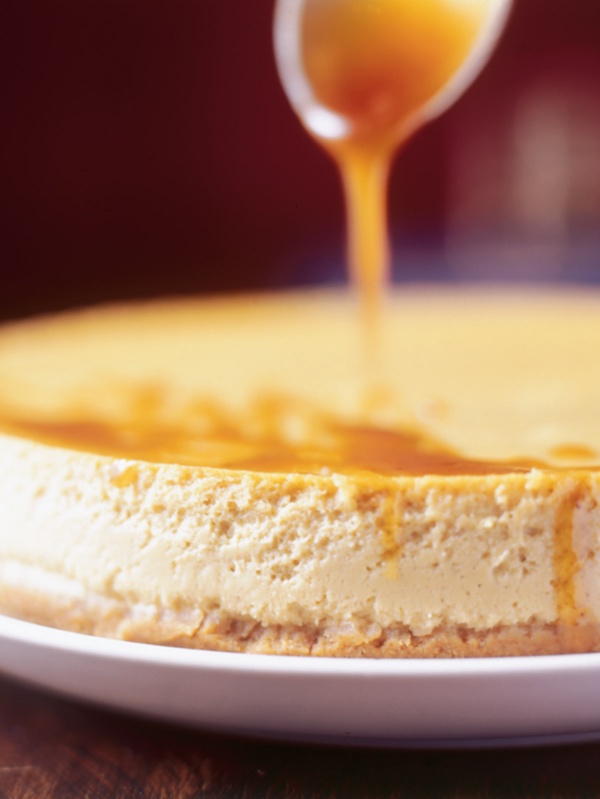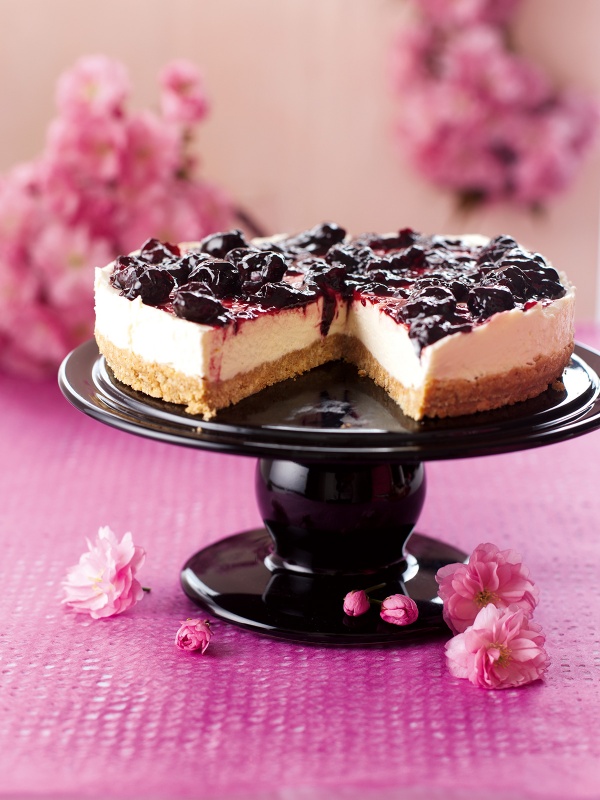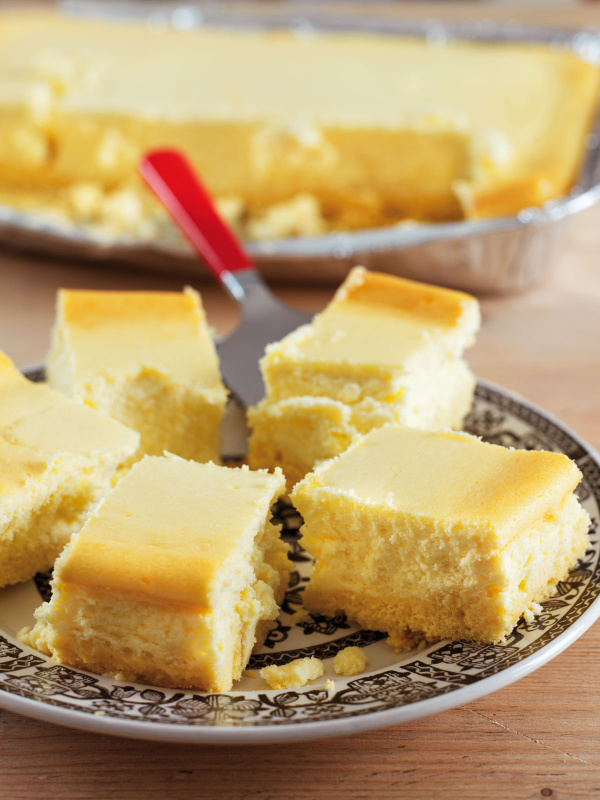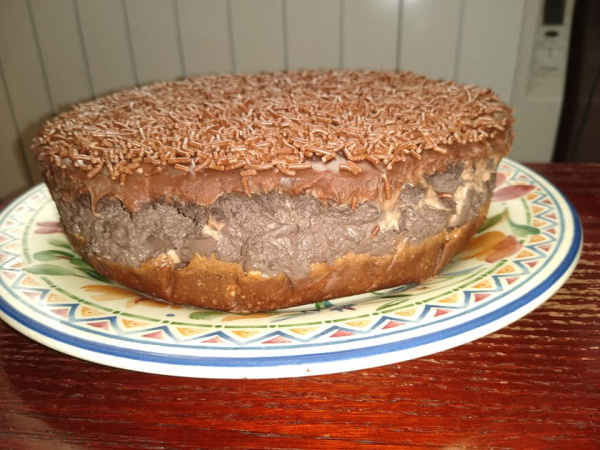Chestnut Cheesecake
by Nigella. Featured in FEASTIntroduction
There is no doubt about it, anything with chestnuts in it, even if they come vacuum-packed or canned and are perennially available, is so right for this time of year. The chestnuts are present, in the form of a gritty, grainy sweetened purée: some to add to the biscuit base; some to fold through the plain cheesecake filling before baking; and yet more — well, it is Christmas — to drip in a thick syrup over the cake when served. And yet, you know, the chestnuttiness is not blaring: there is something undeniably festive about this, but not in a full-on, party hat kind of a way.
As with all cheesecakes, you need to bake this the day before you want to serve it.
For US cup measures, use the toggle at the top of the ingredients list.
There is no doubt about it, anything with chestnuts in it, even if they come vacuum-packed or canned and are perennially available, is so right for this time of year. The chestnuts are present, in the form of a gritty, grainy sweetened purée: some to add to the biscuit base; some to fold through the plain cheesecake filling before baking; and yet more — well, it is Christmas — to drip in a thick syrup over the cake when served. And yet, you know, the chestnuttiness is not blaring: there is something undeniably festive about this, but not in a full-on, party hat kind of a way.
As with all cheesecakes, you need to bake this the day before you want to serve it.
For US cup measures, use the toggle at the top of the ingredients list.

Share or save this
Ingredients
Yields: 8 slices
For the Base
- 250 grams digestive biscuits
- 50 grams soft butter
- 1 tablespoon sweetened chestnut puree
For the Cheesecake
- 500 grams cream cheese
- 125 grams caster sugar
- 3 large eggs
- 3 large egg yolks
- 175 millilitres sour cream
- 1 teaspoon fresh lime juice
- 1 teaspoon vanilla extract
- 2 tablespoons rum
- 350 grams sweetened chestnut puree
For the Syrup
- 80 millilitres water
- 60 millilitres rum
- 1 tablespoon sweetened chestnut puree
- 50 grams caster sugar
- 15 grams butter
For the Base
- 9 ounces graham crackers
- 3 tablespoons soft butter
- 1 tablespoon sweetened chestnut puree
For the Cheesecake
- 1 pound cream cheese
- ⅔ cup superfine sugar
- 3 large eggs
- 3 large egg yolks
- ¾ cup sour cream
- 1 teaspoon fresh lime juice
- 1 teaspoon vanilla extract
- 2 tablespoons rum
- 1⅓ cups sweetened chestnut puree
For the Syrup
- 5 tablespoons water
- ¼ cup rum
- 1 tablespoon sweetened chestnut puree
- ¼ cup superfine sugar
- 1 tablespoon butter
Method
- Preheat the oven to gas mark 4/180°C/160°C Fan/350°F, and put the kettle on to boil.
- For the base, process the biscuits, butter and heaped tablespoon chestnut purée until like fine crumbs. Press the mixture into the bottom of a 23cm / 9inch springform cake tin and place in the fridge while you make the filling.
- Beat the cream cheese until smooth and add the sugar. Add the eggs and egg yolks, beating them in one by one until they are incorporated into the cream cheese and sugar. Pour in the sour cream, lime juice, vanilla extract and rum, and beat again until smooth and creamy. Finally fold in the sweetened chestnut purée. Don’t worry about making a fully amalgamated mixture: smooth cream cheese with grainy streaks of chestnut is just fine.
- Line the outside of the springform tin containing the biscuit base with a good wrapping of clingfilm, so that the whole of the bottom and sides are enveloped in cling.
- Do the same with foil, covering the layer of clingfilm to make a very watertight casing.
- Stand the springform, thus covered, in a roasting tin and pour in the chestnut filling. Once that’s done, pour water from a recently boiled kettle into the roasting tin to come about 3cm / 1¼ inches up the side of the cake tin (the cling will make it bob up and down a bit) and place in the oven to cook for an hour.
- When the cheesecake’s ready it should be just set on top with a hint of wobble underneath; it certainly carries on cooking as it cools. Take the cheesecake out of the roasting tin, take off the foil and clingfilm wrapping and let the cheesecake cool on a rack.
- Refrigerate overnight before unmoulding and leaving it to get back to room temperature.
- If you need to unmould it long before you want to eat it (I often do just because I like to get all bothersome stuff out of the way before people arrive) then just sit it on its serving plate in the fridge until about 20–30 minutes before you want to eat it. I’d take it out as you sit down to dinner or lunch or whatever.
- You can make the syrup in advance but do not pour over until the actual point of serving. You just put all of the syrup ingredients into a saucepan and melt together. Let the syrup boil until thickened slightly, then cool to just warmish (or even room temperature) before criss-crossing the top of the cheesecake with it.
- Preheat the oven to gas mark 4/180°C/160°C Fan/350°F, and put the kettle on to boil.
- For the base, process the biscuits, butter and heaped tablespoon chestnut purée until like fine crumbs. Press the mixture into the bottom of a 23cm / 9inch springform cake tin and place in the fridge while you make the filling.
- Beat the cream cheese until smooth and add the sugar. Add the eggs and egg yolks, beating them in one by one until they are incorporated into the cream cheese and sugar. Pour in the sour cream, lime juice, vanilla extract and rum, and beat again until smooth and creamy. Finally fold in the sweetened chestnut purée. Don’t worry about making a fully amalgamated mixture: smooth cream cheese with grainy streaks of chestnut is just fine.
- Line the outside of the springform tin containing the biscuit base with a good wrapping of clingfilm, so that the whole of the bottom and sides are enveloped in cling.
- Do the same with foil, covering the layer of clingfilm to make a very watertight casing.
- Stand the springform, thus covered, in a roasting tin and pour in the chestnut filling. Once that’s done, pour water from a recently boiled kettle into the roasting tin to come about 3cm / 1¼ inches up the side of the cake tin (the cling will make it bob up and down a bit) and place in the oven to cook for an hour.
- When the cheesecake’s ready it should be just set on top with a hint of wobble underneath; it certainly carries on cooking as it cools. Take the cheesecake out of the roasting tin, take off the foil and clingfilm wrapping and let the cheesecake cool on a rack.
- Refrigerate overnight before unmoulding and leaving it to get back to room temperature.
- If you need to unmould it long before you want to eat it (I often do just because I like to get all bothersome stuff out of the way before people arrive) then just sit it on its serving plate in the fridge until about 20–30 minutes before you want to eat it. I’d take it out as you sit down to dinner or lunch or whatever.
- You can make the syrup in advance but do not pour over until the actual point of serving. You just put all of the syrup ingredients into a saucepan and melt together. Let the syrup boil until thickened slightly, then cool to just warmish (or even room temperature) before criss-crossing the top of the cheesecake with it.
Additional Information
MAKE AHEAD / STORE:
The cheesecake will keep, covered, in the fridge for a total of 4 days. The cheesecake can be frozen if made with full-fat cream cheese. Wrap the fully-cooled cheesecake (still in its tin) tightly in a double layer of food wrap and a layer of foil. Freeze for up to 1 month. Unwrap, cover loosely and thaw for 24 hours in the fridge.
MAKE AHEAD / STORE:
The cheesecake will keep, covered, in the fridge for a total of 4 days. The cheesecake can be frozen if made with full-fat cream cheese. Wrap the fully-cooled cheesecake (still in its tin) tightly in a double layer of food wrap and a layer of foil. Freeze for up to 1 month. Unwrap, cover loosely and thaw for 24 hours in the fridge.






Tell us what you think
Thank you {% member.data['first-name'] %}.
Explore more recipesYour comment has been submitted.